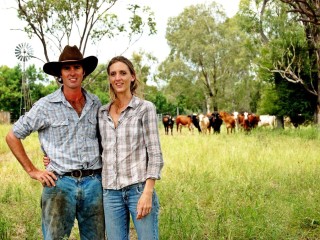 Central Queensland cattle producers Richard and Victoria Moffat say that getting to know their “cost of carry” has helped to more accurately identify whether cattle trades will be profitable, and to optimise cash flow for their business.
Central Queensland cattle producers Richard and Victoria Moffat say that getting to know their “cost of carry” has helped to more accurately identify whether cattle trades will be profitable, and to optimise cash flow for their business.
The couple, from Muldoon near Marlborough, were introduced to the concept during a two-day workshop run by KLR Marketing in Emerald in 2009.
Cost of carry refers to costs incurred as a result of an investment position, and may not involve the actual costs associated with producing a product, such as a kilogram of beef.
For example a producer can buy in a 300kg steer, hold it for a month, and it may not have put on any weight in that time, but they have still incurred costs such as transport.
The ability to accurately calculate cost of carry allows producers to complete a sell/buy formula that will tell them if a particular trade is likely to be profitable or not.
The Moffats are now able to break their cost of carry down to a per head basis.
“By knowing our cost of carry, we have a margin from where we can determine whether a class of animal is underpriced or overpriced in the market,” Mr Moffat said.
“Being able to look at our cost of carry on an annual or per head figure basis allows us to use the grass we have on-hand to maximise profit.”
Mr Moffatt said he was not picky about what class of cattle he bought, so long as it came with the opportunity for profit.
“I buy anything that I can make money out of,” he said.
“I could go to a sale and any class of animal can come home on my truck, it doesn’t really matter.
“At the moment, we feed a lot of cattle up to feedlot entry weights and for anything that blows out of that weight grid we see if we can carry it forward to a kill weight at a profit.
“We’ve also got breeders at the moment and sell some as pregnancy-tested-in-calf (PTIC) and calve down others, depending on what’s most profitable at the time.
“If that animal is not paying its way anymore, then we look to trade that animal back into the market where that money is going to return us a positive gain on another class of animal.”
The Moffatts operate 3240 hectares (8000 acres) in a rotational grazing system, with pastures dominated by softwood scrub country through to River Bluegum, and Brigalow country to open Soft Bloodwood forest country.
Pastures include Leucaena, buffel grass, native bluegrass, black spear grass, and green panic.
Mr Moffatt said he normally ran 1000 young cattle and 200 to 250 breeders.
Mr Moffat said that being able to identify cost of carry and therefore whether or not a trade was likely to be profitable had also improved his ability to make a sell decision to create cashflow as required for the business.
“Cashflow is everything, really, especially in the current environment we live,” he said.
“What banks really want to know about is cashflow – not equity.
“Whether you’re a breeder or whatever operation you run, understanding your cost of carry will help you to access cashflow from your livestock enterprise.”
• KLR Marketing will hold its next school in Brisbane on March 27 to 29. Or more information click here
